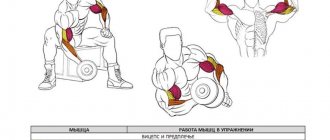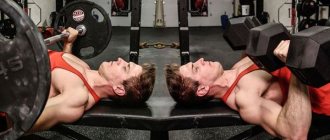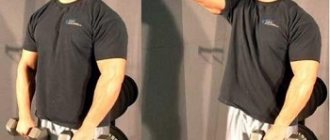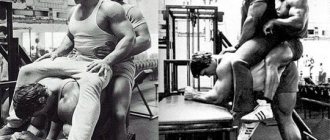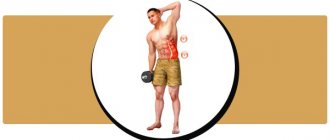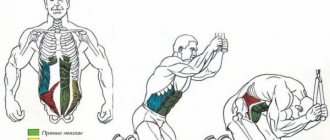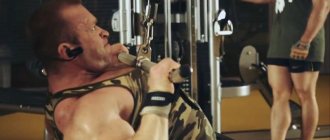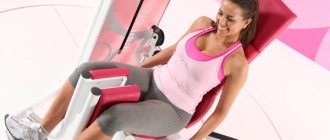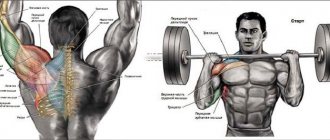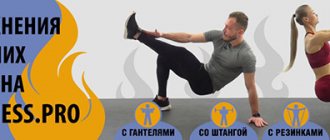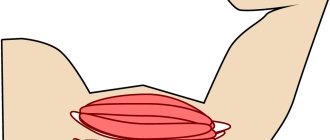What muscles work
In standing dumbbell biceps curls, the brachioradialis and brachialis muscles work the biceps brachii muscle (biceps) is included in the work Dumbbell curls for biceps are also performed in a sitting position, the technique does not change, the only thing is that the body on the vertical bench will be fixed and will not allow the body to sway. Both options can be performed with both hands or alternately.
Lifting dumbbells for biceps while standing, sitting, with and without supination from A to Z!
Good day, friends. In today’s episode, we’ll talk about a lot of exercises aimed at working out the muscles of the arms, namely for the BICEPS - standing dumbbell lifts for biceps and its various modifications (standing, sitting, alternately, with supination without, etc.), lifting dumbbells on an inclined and a horizontal bench and DUMBELL LIFT ON A SCOTT BENCH.
After reading the article, you will learn everything from A to Z about these exercises, i.e. about all their subtleties and secrets, what they are, what exactly they are aimed at (the muscles involved), what MODIFICATIONS there are for performing this exercise (standing, sitting, alternating dumbbell lifts, dumbbell lifts with supination, etc.), and in general, how to perform them correctly (technique of execution), I will also tell you about the PROS (advantages) and MINUSES (disadvantages) of these exercises, I will also tell you about the main mistakes most people make when performing these exercises.. well, etc. those. along the way, I will try to raise all sorts of questions regarding these exercises (and accordingly give full answers to them, without lies and falsehood).
Before we begin, I would like to draw your attention to previous editions of exercises related to biceps training, here they are below (if you haven’t read them yet, I recommend following the link and actually reading them):
Dumbbell Raise Modifications
Well, let’s get started with today’s article, I will immediately demonstrate these exercises in reality (so that you roughly understand what will be discussed today) and tell you the technique and features of this or that exercise:
1. Lifting dumbbells for biceps with both hands while standing WITH SUPINATION:
Standing dumbbell curl for biceps with supination
This exercise can also be performed while sitting (again, with both hands with SUPINATION):
Lifting dumbbells for biceps while sitting with supination
Moreover, these exercises can be performed not only STANDING/SITTING, but also not with both hands at once (as shown in the photographs), but ALTERNATELY (i.e. first with the 1st hand, say the right, then with the 2nd hand (left ), etc. left-right-left-right..) or SERIES (first we work out one arm (let’s say the right one), doing, for example, 10 repetitions, then we work out the 2nd arm (left), again doing 10 repetitions).
MOREover, this exercise can be performed WITHOUT SUPINATION AT ALL (i.e. without turning the wrists), then it will just be ordinary dumbbell curls for biceps, see photo below:
Standing dumbbell curl
And again, in this version we lift the athlete with both hands at once; this can be done alternately (left-right-left-right) or in series (i.e. first one hand, then the other).
Actually, lifting dumbbells for biceps is a BASIC EXERCISE aimed at developing the biceps brachii muscle (i.e. biceps) and forearm (brachioradialis) and to some extent also loads the brachialis muscle (i.e. BRACHIALIS). But the main load vector falls precisely on the BICEPS. You can read more about the muscles involved in the photo below:
Muscles involved in the dumbbell biceps curl exercise
Features and technique of performing this exercise
All this (what I talked about above) is essentially the same exercise, there are small differences that I will tell you about now (this applies to working with or without supination), but basically they are simply performed differently (sitting or standing, with one hand or both at once..), that's all.
What is the best way to do it with or without supination, and what is the difference?
In my opinion, it is much more effective to perform it WITH SUPINATION!!! Because when supination occurs, two functions of our biceps are involved at once. What other functions, you ask. The fact is that the BICEPS has a main function: FLEXING THE ARM AT THE ELBOW JOINT. But, in addition to flexion, there is another function (which works only under the condition of SUPINATION, few amateurs know about it, and yet), its essence is that the biceps can supinate our arm (that is, turn the forearm outward, towards the thumb) , do you understand? This happens due to the anatomical location of our biceps (namely its tendons, which are attached at an angle, in the upper part of our forearm), in general, this is a jungle that you are unlikely to understand, there is no point in describing further, so just remember, THE BICEPS HAS TWO FUNCTIONS (flexion of the arm at the elbow joint and the supinating function of our biceps), and due to the fact that WE CAN SUPINATE OUR HANDS (turn towards the thumb), we work out our biceps more COMPLETELY (better).
But if we just did dumbbell curls for the biceps (WITHOUT SUPINATION), then only ONE FUNCTION OF THE BICEPS (the main one) would work for us, i.e. ARM BENDING AT THE ELBOW JOINT, and also WHEN SUPINATION, TWO FUNCTIONS WORK AT ONCE (hence, the biceps is worked out in full).
CONCLUSION: in my opinion, it is better to do lifts with SUPINATION.
But here (WHEN SUPINATION) there is a TRAP that many people fall into. The essence of the trap is that people grab the dumbbell incorrectly. Now I will explain.
The fact is that when you work WITH SUPINATION (i.e. rotation of the hand), then you need to hold the dumbbell in the correct way, namely, hold on to the TOP PART OF THE DUMBBELL (closer to the thumb). This is done specifically so that the part of the dumbbell that is closer to the little finger is HEAVY than the part of the dumbbell that is closer to the thumb. Why is this being done, you ask. The fact is that if you take it correctly (i.e. closer to the thumb), then the part of the dumbbell that is closer to the little finger will be heavier (and we need this), because you will be at the expense of it supinating function of the biceps to unfold. Do you understand? You cannot hold the dumbbell close to your little finger, otherwise the unfolding function of the biceps will not be activated, and the whole point is lost. Do you understand what a serious mistake can be made without even starting to do the exercise itself?... This is very important, see the photo below (explanation):
WHEN SUPINATING, you need to hold the dumbbell closer to the thumb (i.e., by the upper part)
Now let's discuss the execution technique. In general, we found that the exercise is best performed with SUPINATION (because it works two functions of the biceps at once, therefore, it is worked out more efficiently), and the exercise can be performed both standing and sitting. This is not so important, but in my opinion, it is much more effective to do it while standing, because this way it will be easier and simpler for you to lean forward/backward, lower your shoulders and press your elbows to your body, and thanks to this, it will be much easier for you to complicate yourself in this position the technique of performing this exercise (and the bodybuilder’s goal is not to make his life (exercise) easier, but rather to make his life as heavy as possible), and if you perform it while sitting (then it will be difficult for you to lean forward/backward, press your elbows against your body, your pelvis will interfere with you) and LEGS), therefore, the conclusions are obvious to me, I am a supporter of doing it only while standing, which I recommend to you (but in any case, see for yourself).
Next, we take the dumbbells in our hands (with an underhand grip), and do not forget what I told you (about the supinating function), i.e. hold the dumbbell by the upper part (closer to the thumb), the dumbbells are in your lowered hands, palms facing inward, press your elbows closer to your body, if you did everything correctly, you will look something like this, see photo below:
Lifting dumbbells for biceps low point
This is your starting position. From there, you INHALE and hold your breath, and begin to bend your arm at the elbow joint (i.e., begin to lift dumbbells). An important nuance: if you are going to do WITH SUPINATION (which I recommend), then from approximately the bottom position (starting position), almost immediately begin turning your hands outward (i.e., start supination). At the same time, without stopping the exercises, do not try to lift the dumbbells as high as possible (towards your shoulders, no.. you don’t need to do this, your goal is to bend your HANDS AT THE ELBOW JOINT, without bringing your elbows forward and, as if throwing the dumbbell over yourself on the shoulders), see photo below (explanation of what not to do):
Dumbbell curls (wrong)
There is no need to do this!!! YOUR HANDS should be pressed to your body (they should not go forward or backward, they are strictly vertical, i.e. parallel to the floor throughout the entire movement), bending occurs only at the elbow joint!!!! See the photo below (correct and incorrect):
Lifting dumbbells for biceps (correct and incorrect)
In general, we bend the arm at the elbow joint (only due to the strength of the biceps), there is no need to throw the dumbbells up (bringing the elbows forward), there is no need to cheat by swinging the body, we work only due to the strength of the arm muscles, namely the BICEPS!!!!! In general, we bent the arm, stayed in this position (for 1-2 seconds) making a peak contraction, after which we slowly, under control, lower the dumbbells to the lowest point (starting position), while rotating the hands (supination) only in the reverse order.
Ps please note that when you lower the dumbbell down (to the lowest point) at the lowest point do not extend your arm to the end (do not straighten it), on the contrary, your arm should be slightly bent at the elbow (SPECIALLY) so that the load does not leave the muscles ( namely biceps), but on the contrary was constantly preserved. It is very important.
Well, that's all. If you do this exercise without supination, then the technique of execution is no different (only in that you do not supination), otherwise everything is the same. Absolutely nothing changes. I've given you all the information you need (well, I hope so), go for it, good luck.
I also recommend taking a look at the video demonstration of this exercise:
Now let's move on to the next biceps exercise.
2. Lifting dumbbells for biceps on an incline bench (almost lying down)
Dumbbell curls on an incline bench
Or this exercise can be performed on a horizontal bench (i.e. lying down), see photo below:
Lifting dumbbells for biceps on a horizontal bench
This exercise can be performed with both hands at once, or ALTERNATIVELY (i.e. first with the 1st hand, say the right, then with the 2nd hand (left), etc. left-right-left-right..) or IN SERIES (first we work out one arm (let’s say the right one), doing, for example, 10 repetitions, then we work out the 2nd arm (the left one), again doing 10 repetitions). Personally, I like to do it alternately (left-right-left-right, etc.), but you can see for yourself.
Features of the exercise (biceps curl on an incline or horizontal bench)
Why is this even being done? (such bench tilts)
BICEPS (external and internal bundle)
The fact is that our BICEPS consists of TWO BUNCHES (BI means 2): EXTERNAL and INTERNAL (see photo above). Almost all biceps exercises develop the INNER BICEPS BAND, and only a few (there are very few of them, but this is one of them) develop the EXTERNAL HEAD OF THE BICEPS. Often in athletes you can see huge internal bundles, and lagging external bundles, all for one reason, most biceps exercises develop the internal, and not the external bundles. This is the peculiarity of this exercise (the whole highlight, so to speak).
CONCLUSION: this exercise develops the external bundle of the BICEPS.
Why does it develop external, and not internal, like all other exercises?
As you may have noticed, THE EXERCISE IS PERFORMED ON AN INCLINED OR EVEN A HORIZONTAL BENCH. What does this give? This makes it possible to move your ELBOWS AS FAR BACK AS POSSIBLE (behind your back), due to this, the INTERNAL BUNCH OF THE BICEPS is included in the work. Do you understand? Usually (in all other exercises) for biceps, the elbows are brought forward, and this is actually why the INNER HEAD OF THE BICEPS works. That's all the secret, if you can call it that)).
Again, this exercise can be performed with or without SUPINATION. Personally, I do not recommend supinating the arm in this exercise; there are other much effective exercises for this. THE PURPOSE OF THIS EXERCISE IS TO DEVELOP THE EXTERNAL BUNCH OF THE BICEPS (the one that often lags behind in everyone).
Technique for performing this exercise
Personally, I recommend that you perform this exercise on a HORIZONTAL BENCH (i.e. generally lying down). Why is this so? Because this way, firstly, you move your elbows back even more (as if behind your back), due to this your biceps will contract even better, and secondly, this way you have a much greater AMPLITUDE OF MOTION IN THE STRAIGHT POSITION OF YOUR BICEPS. This is very, very, very good, and these are the two features that lead the BATTLE OF WHICH ANGLE TO SET. Many people set the slopes to 45 degrees (some even higher), I think this is not correct, you need to set either 25 degrees or the full horizon... in fact, the lower = the better. But it's up to you.
In general, we take dumbbells in our hands, sit on a bench (and lie down on it if you are using a horizontal bench, as I recommended, or reclining if the inclination is 25 degrees), while your hands with the dumbbells are lowered down. Next, you need to PRESS your hands CLOSER TO THE BODY (on the sides). See below (starting position):
Raising dumbbells for biceps on an incline bench (lowest point)
This is done on purpose, the fact is that if you do not press your elbows to your torso (body), then when you lift the dumbbells up (from the bottom position), you will spread your arms to the side (far from the body), and this in turn is not correct BECAUSE THIS REMOVES THE LOAD FROM THE OUTER HEAD AND SWITCHES TO THE INNER. But we don’t need this, because our goal (and in general the goal of this exercise) is to train the OUTER HEAD!!!! Do you understand? Therefore, we press our elbows to the body (torso) and only then raise our hands up (to the top point), stay there for 1-2 seconds (doing a peak contraction) and only after that, SLOWLY UNDER CONTROL LOWER THE DUMBBELLS TO THE BOTTOM (to the bottom point). See the photo below:
Incline Dumbbell Curls (Top Point)
Ps also pay attention to the fact that, AT THE BOTTOM POINT (WHEN YOU LOWER THE DUMBBELLS DOWN), you should not extend your ARMS TO THE END, ON THE CONTRARY YOU NEED TO KEEP YOUR ARMS Slightly BENT AT THE ELBOW, SO THAT, firstly, THE LOAD DOES NOT LEAVE YOUR BICEPS (and on the contrary, it was constantly preserved), and secondly, in order not to load your ligaments (in the starting position) + besides, you can easily get injured, do you need it? You don’t need it, so we don’t fully extend our arms (at the elbows).
Pps also pay attention to the UPPER POINT (when you lift the dumbbells UP), you should not throw them (all the way onto your shoulders), this is not correct!!!! Your goal is to bend your HANDS AT THE ELBOW JOINT, without bringing your elbows forward (you took your elbows back, all the way behind your back, and keep them there throughout the entire movement), in no case help yourself by bringing your elbows forward, and as if throwing put a dumbbell on your shoulders, because this is not right!!!! We work only due to the strength of the arm muscles, namely the BICEPS!!!!! I've given you all the information you need (well, I hope so), go for it, good luck.
I also recommend taking a look at the video demonstration of this exercise:
Now let's move on to the next biceps exercise.
3. Lifting dumbbells for biceps with both hands while sitting in a Scott bench:
Scott Bench Dumbbell Curls
Also, this exercise (i.e., lifting dumbbells for biceps while sitting on a Scott bench) can be performed with 1 hand, see photo below:
One-arm dumbbell curls on a Scott bench
In general, this exercise can be performed with both hands at once, or in SERIES (first we work out one hand (for example, the right one), for example, do 10 repetitions, then we work out the 2nd hand (the left one), again doing 10 repetitions), I personally like perform (if you do) then first the series with one hand, then with the second. But you, see for yourself.
Lifting a dumbbell on a Scott bench, as well as lifting an EZ barbell (in a Scott bench, is an isolating exercise), it is aimed at working the biceps brachii muscle (i.e. BICEPS), namely its middle and bottom. Many believe that this exercise specifically develops the BOTTOM OF THE BICEPS. Honestly, I don’t know if this is actually true (I’m not sure about this), in my opinion, the ENTIRE BICEPS contracts completely; how it can contract in parts has not yet dawned on me)).
This exercise can also be performed STANDING (not just sitting), I personally like to perform it standing (because this, in my opinion, increases the stability of the core), but in any case, try both sitting and standing, and choose the optimal one for yourself option. Many people, on the contrary, are not comfortable standing; they feel more comfortable sitting, so try it...
We take dumbbells in our hands, if you do it with both hands, if you do it with one hand (in series), and then with the second, then you take not two dumbbells, but one. Grab the dumbbell with an underhand grip (of course, hehe), in this exercise I do not recommend using SUPINATION (do regular lifts), in general, take a dumbbell (or dumbbells) and now you need to rest with your upper arm (it starts from bending your elbow), those. TRICEPS and above, pressing them tightly to the surface of the machine (i.e., press them into the bench).
Ps it is very important that you do not lift your TRICEPS off the bench during the exercise, they must be pressed throughout the entire movement!!!!
And so I repeat, the triceps are pressed to the bench (do not come off), the width of the grip (the distance between the dumbbells) can be different, WIDE or NARROW (relatively speaking). If you use a narrow grip, the load will go to the outer part of the biceps. If you take it wide, the load will be on the inside of the biceps.
Ps in my opinion, the width of the grip does not matter in this exercise to emphasize this or that head, BECAUSE in this exercise our elbows are brought forward (remember the rules that I told you about above), i.e. The more the elbows are brought forward, the more the internal biceps muscle works. THEREFORE, in this exercise, in any case, the INNER BUNCH will work (and not the external one). Personally, I take (if I work with two dumbbells) a medium grip (I don’t spread the dumbbells too wide apart from each other, and I don’t bring them too close), something in the middle (to be honest, I rarely work with two dumbbells at all), I prefer with one .
At the lowest point (but the arms are not fully extended, they are slightly bent at the elbow joint, so that, firstly, a constant load is maintained in the biceps (i.e., so that the load does not go away), and secondly, so as not to get injured (not injure your ligaments)). If you did everything correctly, you will look something like this, see photo below:
One-arm dumbbell curl on a Scott bench (starting position)
This is your starting position (this is the bottom point). Next, you need to lift the dumbbell up from it (bend your arm at the elbow joint). BUT!!!! It is very important that you do not raise your arms all the way to the top (don’t raise them too high), to do this, watch the very bottom of the elbow, if it comes off = it means you raised it too high, if it doesn’t come off = then everything is OK, in general, FLEXION OCCURS ONLY AT THE ELBOW JOINT (NOT HIGHER), YOU DO NOT NEED TO PLAY THE DUMBBELL(S) UP AT HAPPY. In general, bend your arms at the elbow, stay there for 2 seconds (making a peak contraction), after which you slowly lower the dumbbell down under control (but not to the very end, do not straighten your arm completely, otherwise it is easy to injure the ligaments, and the load will go away with biceps, but we don’t need that). See the photo below to see what the top point will look like:
One-arm dumbbell curl on a Scott bench (top point)
Well, that's basically it.
Again, I recommend taking a look at the videos that clearly demonstrate this exercise:
- here we talk about bending with both a barbell and dumbbells:
— and here we only talk about curls with dumbbells:
As for WHO AND WHEN TO PERFORM THESE EXERCISES (all three exercises that we discussed today) and in WHAT NUMBER OF APPROACHES/REPEATS, then everything is purely individual. All I can recommend for most people is 3-4 sets (working) of 6-12 reps. Why I always recommend this way, you can read in the main articles (learn about all this in more detail), here they are => “How many approaches to do the exercises” and “How many repetitions to do in the approach?”, to whom and when should I do it, to Unfortunately, I can’t say, because everything depends on many factors (features) of a particular person, and without knowing him inside and out, my recommendations will be in one place... don’t get me wrong (well, if I’m going to blurt out something about this, then the second and third exercises are not for beginners and not even for more advanced ones, therefore for most I recommend the first, i.e. lifting dumbbells for biceps with supination), but professionals decide for themselves what, when and how to do them. These are the pies)).
I strongly recommend that those wishing to realize their desires purchase and study my books:
This is where I end this issue, I hope you found it INTERESTING and INFORMATIVE.
For dessert - a video: a cruel prank in the form of a kidnapping in broad daylight and its consequences:
If you don't mind/feel sorry, please share the link to the article on social networks (social buttons are below). This is the best you can do, I will really, really appreciate it.
Best regards, administrator.
Technique: lifting dumbbells for biceps
- Standing or sitting, legs are shoulder-width apart. We hold dumbbells in our hands, placing them on the sides near the hips.
- Exhale: bend one arm at the elbow, working through the biceps.
- Inhale: Extend your elbow three times slower than bending, smoothly performing the movement.
Perform the same number of times on each hand. It is optimal to do 3–4 approaches, depending on the level of physical fitness and working weight, 8–12 repetitions.
Incline dumbbell curls for biceps
An excellent alternative to classic lifts, which is performed lying on a bench at an angle of 45 degrees. With this option, the biceps receives an isolated load at the top point when the hands are supinated. The shoulder and brachioradialis also work.
In this option, it is impossible to perform cheating - swinging the body, and perform bending by inertia.
- Set the bench at an angle of 45 degrees, hold dumbbells in your hands and sit on the bench, lower yourself onto your back.
- Hands in a hanging position under the bench.
- Keep your head up while watching the movement of your arms. For pain in the shoulder joints, perform the option on a bench while sitting at an angle of 90 degrees.
- Exhale: first, bend with one arm; in the middle of the movement, turn the hand toward the shoulder, contracting the biceps as much as possible in the upper phase.
- Inhale: Gently lower your arm without throwing it down, keeping your elbow slightly bent to prevent sprain.
- After full extension, repeat the same movement with your other arm.
Perform 8-12 times on each side alternately, and also 3-4 approaches.
Read about how to perform all variations of supination curls →
Dumbbell raises while sitting on an incline bench: technique, video
Lifting dumbbells for biceps while sitting on an incline bench
– one of the best exercises for the outer biceps.
The technique for performing this movement is quite simple, but novice athletes should know and take into account many features that we will consider in this article.
Most Working out the outer part of the arm is possible only in a certain position - when the elbows are pulled back. Incline dumbbell raises are truly one of the most effective for growing the outer biceps.
Exercise technique
- Choose the optimal angle of the bench - it is recommended from 30 to 60 degrees. Take dumbbells and sit on a bench. Lower your arms, straighten your back, take a strong position.
- Perform biceps curls with one arm and then with the other. You can also perform curls with both arms at once, but for beginners, the first option is more preferable, as it allows you to better concentrate on performing the lift.
- When lifting a dumbbell, movement occurs only due to the force of the biceps; the shoulder joint is fixed and does not move.
- When lowering the dumbbell, it is not recommended to fully extend the arm at the elbow joint - this will ensure constant tension in the target muscle and reduce the likelihood of ligament injury.
You can study the technique of this exercise in more detail using the video at the end of this article.
Common beginner mistakes and recommendations
- Many novice athletes, while lowering the dumbbell, throw it too sharply and injure their ligaments, and sometimes the elbow joint. All movements in this exercise should be smooth.
- When doing biceps curls while sitting on an incline bench, you should keep your arms as close to your body as possible and not spread them to the sides.
- The shoulder joint should be fixed and not help lift the dumbbell at the highest points of the amplitude; this is necessary so that tension is constantly maintained in the target muscle.
- Alternatively, you can try performing supinated dumbbell curls to target more of the smaller muscle areas and get a better biceps contraction.
How to use this exercise in training
As we have already said, dumbbell biceps curls while sitting on an incline bench are an accentuated exercise that works the outer fascicles of the biceps. You should not start your workout with such an isolation exercise; most experienced athletes use this movement to finish off their biceps at the end of the workout. We recommend starting with more basic exercises and then moving on to isolated work. It roughly looks like this:
- Close grip pull-ups for biceps;
- PSHNB standing;
- Exercise hammer;
- PSHNB with reverse grip;
- Dumbbell bicep curls while sitting on an incline bench.
For amateur athletes, two or three exercises for training the biceps are enough, but you can perform 5 movements in one session if you reduce the number of approaches in each of them. Do not forget that the biceps themselves are not a very large muscle group, and therefore it is not very wise to devote a separate workout to them, especially if you are involved in bodybuilding at an amateur level. It is best to train the biceps with other muscle groups, preferably the triceps, back or pecs.
Technique for performing dumbbell lifts on an incline bench from Denis Borisov
Dumbbell Concentration Curls
Another great exercise for isolated biceps work. In a sitting position, first bend with dumbbells with one hand, then change to the other. Its essence is that the elbow is pressed against the inner surface of the shoulder, and it will be impossible to perform a jerk. In this case, you won't need a lot of dumbbell weight.
Read more about concentrated biceps curls here →
Types of biceps exercises with dumbbells
- Lifting dumbbells for biceps while standing (only at first glance it seems that this is the same exercise as with a barbell);
- Hammer exercise (a good basic exercise where, in addition to working the biceps, it is possible to develop the shoulder girdle);
- Lifting dumbbells for biceps while sitting on a bench (middle part of the workout);
- Concentrated curling of the arm with a dumbbell while sitting (it is possible to achieve the greatest muscle contraction);
- Bending your arms while sitting on an incline bench (a complex and very working exercise in which it is impossible to “cheat”);
- Biceps exercises with dumbbells on a Scott bench (one of the most effective auxiliary loads)
And now - in detail about the technique and precision of performing each exercise.
Dumbbell curls on a Scott bench
On the L. Scott bench, you can qualitatively work out the biceps brachii muscle, similar to concentrated lifts, or bending on an inclined bench, the muscle is completely isolated . With this technique, the elbows rest on a special board of the Scott bench, and simultaneous or alternate bending with dumbbells is performed. When lifting one dumbbell, you can use your other free hand to help your biceps complete the last reps to failure by slightly pushing your forearm.
How to properly work on a Scott bench is written in this article →
Execution technique
The classic version of bending on an inclined bench is performed with supination. That is, during the lift we do not constantly rotate the dumbbell clockwise towards the thumb. And we do it right away and fix our forearms in this position. Next, you should choose the angle of the bench. Here you need to build on the athlete’s level of training. The lower we lower the back, the more difficult it is to perform this exercise. For beginner athletes, an angle of 70° is recommended. Professionals change the angle in each approach. Starting from 45° and ending almost horizontally. This allows you to work your biceps from a variety of angles. Giving him more incentive to grow. Now you can start doing the exercise.
Initial position:
- Set the back of the bench press at the desired angle. The seat should also be raised. This will prevent us from sliding down the bench and will make the exercise more comfortable.
- Take two dumbbells of the required weight and sit on a bench.
- We bring the shoulder blades together and, together with the lower back, press them against the back.
- We put our legs on the sides and firmly rest our feet on the floor.
- We lower our hands with dumbbells down until they become perpendicular to the floor.
- Shoulders are down. Hands are pressed to the body.
- We supinate the hands. To do this, turn them clockwise towards the thumb.
Performance:
- As you exhale, bend your arms at the elbow joints and lift the dumbbells up.
- We do not stay in this position for long in order to reduce the biceps as much as possible.
- Then, as you exhale, slowly and under control lower the dumbbells down until the biceps muscle is fully stretched.
Throughout the entire exercise, the body should remain motionless and pressed tightly against the bench. Be sure to watch your breathing. Exhale during the effort, exhale during the easier phase of the exercise. Don't hold your breath! This will create too much pressure in the chest and can lead to a heart attack. The movement should be completely under your control.
Hammer Dumbbell Curl
The hammer grip can be performed both standing and sitting. The technique eliminates supination ; the hands and forearms do not rotate, which increases the load on the brachioradialis muscle. Therefore, this technique is also used to work out the forearms. The “hammer” can be performed either simultaneously with both hands or alternately.
You can familiarize yourself with the “Hammer” exercise technique at this link→
Recommendations: how to properly lift dumbbells for biceps
A huge variety of techniques and options for biceps exercises allows you to choose your own technique for high-quality biceps work without injury, taking into account the individual characteristics of the joints. But don’t get hung up on one option, change sets of exercises, changing grips, equipment, adding the number of exercises to avoid stagnation in progress. It is important that the effortful movement when lifting dumbbells must be performed while exhaling. Moreover, the movement should be quite fast, but not jerky. And the relaxation phase should last three times longer, and must be performed while inhaling. Between approaches, wait 1-2 minutes to recover, do not overload the muscles , otherwise you will get the opposite effect.
Biceps exercises with dumbbells on a Scott bench
The exercise will prevent you from cheating and helping yourself by rocking your back or tilting your shoulder. Physically challenging exercise. It's worth asking someone to be nearby.
Main muscles involved
- The exercise can be done with both hands simultaneously or alternately.
- It is possible to do the exercise either by rotating the hand and raising the wrist, or by statically holding the hand upward, as in lifting a barbell.
- The emphasis should not be higher than the middle of the chest, the shoulder should not lift up.
- As you lift up, concentrate the tension in your biceps.
- When lowering the dumbbells, keep your arm tense and never lower them under the weight. This moment is the most traumatic.
- Watch your breathing.
Technique for performing biceps exercises with dumbbells on a Scott bench
